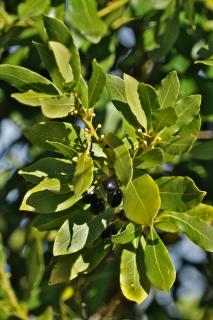

Bay laurel reminds one of the Mediterranean Coast with its very fragrant foliage.
Basic Bay Laurel facts
Name – Laurus nobilis
Family – Lauraceae
Type – shrub, bay
Height – 10 to 24 feet (3 to 7 meters)
Exposure – full sun
Foliage – evergreen
Flowering – Spring
Harvest – all year round
Planting, care and pruning, here is the advice that will make your bay laurel thrive.
Favor planting bay laurel in fall or in spring, avoiding freezing temperatures.
Planting your bay laurel well will ensure proper regrowth and good development.
Making cuttings is the simplest and fastest manner of propagating your bay laurel.
Cuttings is well-suited and usually successful with bay laurel, select softwood stems for the cuttings.

It isn’t really necessary to prune, if only to balance the tree if needed after the blooming.
However, if you wish to prohibit your laurel from self-seeding, prune drastically before flowering.
It is also possible to prune your bay laurel into a shape, like a sphere, a cone, or other topiary shapes. For that, prune off spring and fall growth.
Bay laurel, once properly settled in, requires absolutely no care, unless it is grown in a pot.
Potted bay laurel needs watering whenever the soil has dried up.
Bay laurel must be protected in winter in regions where it often freezes in the cold season, with horticultural fleece.
Bay laurel is favored in gardens for its aromatic leaves that are extremely fragrant.
It is possible to harvest them from March until the first frost spells.
Leaves can be harvested when needed, or they can be collected and dried for keeping.
Finally, remember that bay laurel leaves are great spices both fresh and dried. For the dried ones, use them either whole or powdered.
Fresh laurel leaves tend to be a bit more bitter and more fragrant.
Bay laurel is part of the evergreen shrubs group.
It produces very fragrant leaves that are useful all year long in cooking.
You can use them freshly-picked and also dried several months after their harvest, since their taste keeps well.
Finally, take note that bay laurel leaves are excellent for digestion, all you need to do is infuse 3 bay laurel leaves in one mug boiling water and drink when the water has cooled.
Bay laurel twigs and leaves were intertwined to prepare crown wreaths bestowed upon Roman generals who came back victorious from war in the times of the Roman empire. The same was used in Ancient Greece in for winners of Olympic competitions.
Since bay laurel is one of the herbs that make up bouquet garni, it won’t be difficult for you to prepare your own bouquet garni by adding just a few more herbs to the garden.
To keep savors as long as possible, collect bay laurel leaves preferably when they are in their growth phase.
Dry them for a few days in a dry and ventilated shed before storing them in a jar that seals moisture out.
Aside from bay laurel, bouquet garni most often includes:
See also: how to prepare bouquet garni with plants from your garden
To avoid weed growth and retain water needed for its development, spread mulch at the base of the tree in spring and repeat this every year.